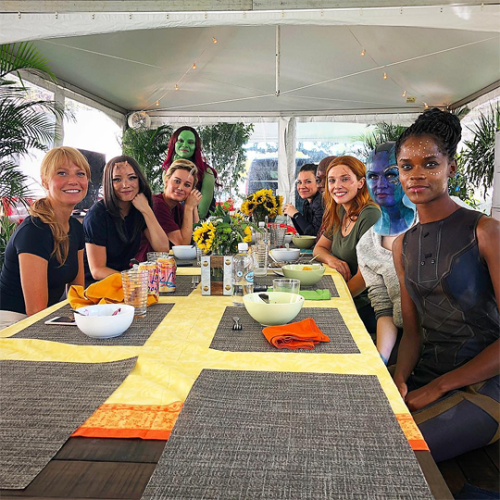Robertdowneyjr #flashback to The #Women of @marvelstudios #mcu lunch I Had The Pleasure Of Hosting… #girlpower #epic #bts (📸 @jimmy_rich) #TeamStark #thankyou


robertdowneyjr #flashback to the #Women of @marvelstudios #mcu lunch I had the pleasure of hosting… #girlpower #epic #bts (📸 @jimmy_rich) #TeamStark #thankyou
More Posts from Dynamic-light-scattering and Others

Hard to argue science with conspiracy theorists


higher further faster gayer




Station 19 - 4x02
only time and chromatography can hahahaha

The lab ran out of balloons that we often use to keep reactions under nitrogen atmosphere and a colleague had a a desperate attempt to use a nitrile glove instead of a balloon.
I think that anyone is able to decide whether or not it has been successful…
MARIA HILL WILL BE IN FAR FROM HOME
MARIA HILL WILL BE IN FAR FROM HOME
This is not a simulation


New stills from Spider-Man: Far From Home (2019)










I like when an article thumbnail features a pic of a woman conductor, as it is the closest I will get to living in a world where newspapers write feel-good human-interest stories about a local witch who is proud to show off her new spell.
I can't wait any longer FOR GOD'S SAKE NAUGHTY DOG



“Life” is just a word for all the trivial stuff that happens while you’re waiting for The Last of Us 2







imagine entering the gym for your daily workout and finding brie on the floor like this
DUDE

Brie Larson

2020 March 25
Star Forming Region S106 Image Credit: NASA, ESA, Hubble Legacy Archive; Processing & Copyright: Utkarsh Mishra
Explanation: Massive star IRS 4 is beginning to spread its wings. Born only about 100,000 years ago, material streaming out from this newborn star has formed the nebula dubbed Sharpless 2-106 Nebula (S106), featured here. A large disk of dust and gas orbiting Infrared Source 4 (IRS 4), visible in brown near the image center, gives the nebula an hourglass or butterfly shape. S106 gas near IRS 4 acts as an emission nebula as it emits light after being ionized, while dust far from IRS 4 reflects light from the central star and so acts as a reflection nebula. Detailed inspection of a relevant infrared image of S106 reveal hundreds of low-mass brown dwarf stars lurking in the nebula’s gas. S106 spans about 2 light-years and lies about 2000 light-years away toward the constellation of the Swan (Cygnus).
∞ Source: apod.nasa.gov/apod/ap200325.html
-
 kamali50220440 liked this · 3 months ago
kamali50220440 liked this · 3 months ago -
 youre-a-w1zard-harry liked this · 5 months ago
youre-a-w1zard-harry liked this · 5 months ago -
 seven1992s liked this · 11 months ago
seven1992s liked this · 11 months ago -
 tinkertaylorjoy liked this · 1 year ago
tinkertaylorjoy liked this · 1 year ago -
 mrs-cookie liked this · 1 year ago
mrs-cookie liked this · 1 year ago -
 ayeemonique liked this · 2 years ago
ayeemonique liked this · 2 years ago -
 spiritualscientist9 liked this · 2 years ago
spiritualscientist9 liked this · 2 years ago -
 lover11sworld liked this · 2 years ago
lover11sworld liked this · 2 years ago -
 how-about-this-name liked this · 2 years ago
how-about-this-name liked this · 2 years ago -
 icouldbemuchworse liked this · 3 years ago
icouldbemuchworse liked this · 3 years ago -
 lovehungrygirl liked this · 3 years ago
lovehungrygirl liked this · 3 years ago -
 javydavy liked this · 3 years ago
javydavy liked this · 3 years ago -
 gnomadhigher-blog liked this · 3 years ago
gnomadhigher-blog liked this · 3 years ago -
 mostly-mortal liked this · 3 years ago
mostly-mortal liked this · 3 years ago -
 themarvelheroes reblogged this · 3 years ago
themarvelheroes reblogged this · 3 years ago -
 steadycolorrascalpainter liked this · 3 years ago
steadycolorrascalpainter liked this · 3 years ago -
 deadlymistress24 liked this · 3 years ago
deadlymistress24 liked this · 3 years ago -
 tilkicioglu liked this · 3 years ago
tilkicioglu liked this · 3 years ago -
 dreamingofoddlydrawnstars liked this · 3 years ago
dreamingofoddlydrawnstars liked this · 3 years ago -
 ifandomus liked this · 3 years ago
ifandomus liked this · 3 years ago -
 muddafuggaz reblogged this · 4 years ago
muddafuggaz reblogged this · 4 years ago -
 brendastuff3 liked this · 4 years ago
brendastuff3 liked this · 4 years ago -
 enchantressnudes liked this · 4 years ago
enchantressnudes liked this · 4 years ago -
 jessblr96 liked this · 4 years ago
jessblr96 liked this · 4 years ago -
 tipsta liked this · 4 years ago
tipsta liked this · 4 years ago -
 annoyedtulip reblogged this · 4 years ago
annoyedtulip reblogged this · 4 years ago -
 castlewyvern liked this · 4 years ago
castlewyvern liked this · 4 years ago -
 sinmatur liked this · 4 years ago
sinmatur liked this · 4 years ago -
 flyfear liked this · 4 years ago
flyfear liked this · 4 years ago -
 katerickey liked this · 5 years ago
katerickey liked this · 5 years ago -
 specific-hux liked this · 5 years ago
specific-hux liked this · 5 years ago -
 yingshuen liked this · 5 years ago
yingshuen liked this · 5 years ago -
 miyalovechocolat liked this · 5 years ago
miyalovechocolat liked this · 5 years ago -
 hettolandija liked this · 5 years ago
hettolandija liked this · 5 years ago -
 oochristinecuoo liked this · 5 years ago
oochristinecuoo liked this · 5 years ago -
 theyelenabelova liked this · 5 years ago
theyelenabelova liked this · 5 years ago -
 elizabeth-arpi liked this · 5 years ago
elizabeth-arpi liked this · 5 years ago -
 cassandra-di-ilio liked this · 5 years ago
cassandra-di-ilio liked this · 5 years ago -
 swb1973 liked this · 5 years ago
swb1973 liked this · 5 years ago -
 universallystudentpalacejudge liked this · 5 years ago
universallystudentpalacejudge liked this · 5 years ago -
 phyrric-victory2427 reblogged this · 5 years ago
phyrric-victory2427 reblogged this · 5 years ago -
 phyrric-victory2427 liked this · 5 years ago
phyrric-victory2427 liked this · 5 years ago -
 hufflepeach reblogged this · 5 years ago
hufflepeach reblogged this · 5 years ago -
 frumiousme reblogged this · 5 years ago
frumiousme reblogged this · 5 years ago -
 thetimesinbetween liked this · 5 years ago
thetimesinbetween liked this · 5 years ago -
 catyuy reblogged this · 5 years ago
catyuy reblogged this · 5 years ago
